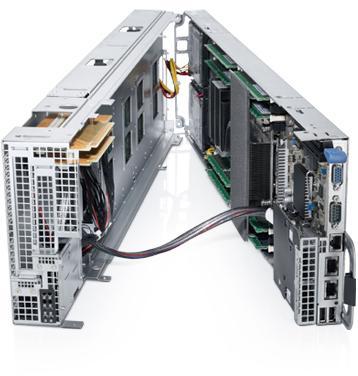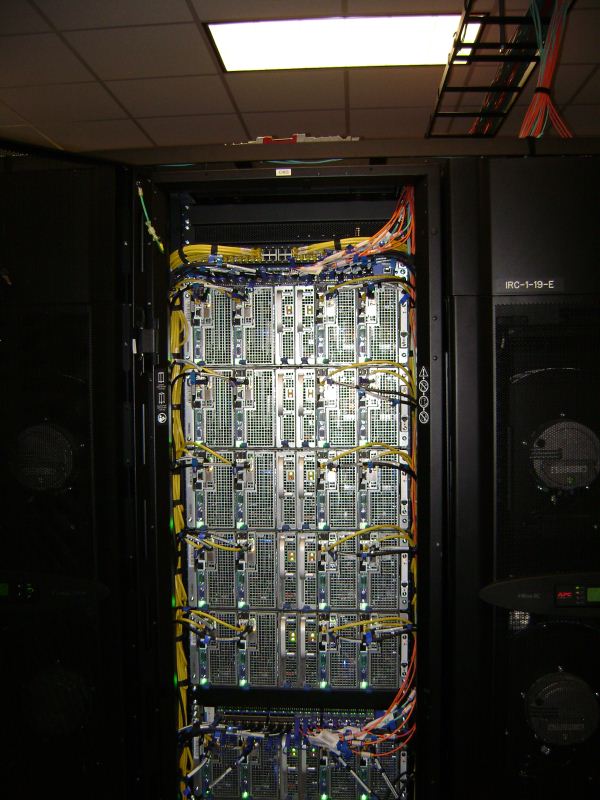The Xeon Phi at work at TACC
by Johan De Gelas on November 14, 2012 1:44 PM EST- Posted in
- Cloud Computing
- CPUs
- IT Computing
- Intel
- Larrabee
- Xeon
- Xeon Phi
We had the chance to briefly visit Stampede, the first Supercomputer based upon the Xeon Phi. This is one of the supercomputers at the Texas Advanced Computing Center (TACC).
Stampede consist of 6400 PowerEdge C8220X and C8220 server Sleds. Typically these servers contain two octal core Xeon E5s, 32 GB of RAM and one GPU/MIC.

Eight of those server sleds find a home inside the C8000 4U Chassis, together with two power sleds.
Dual ported Mellanox ConnectX with FDR infiniband interfaces connects all those servers together to form one large supercomputer. In each rack you can find on 8 C8000s on average.
Connect 200 racks together and you get the Stampede supercomputer:
The Xeon E5s deliver two Petaflops at the moment. When all Xeon Phi are in place, an additional 8 Petaflops will be available to researchers on Stampede.
Intel Xeon Phi is not a standalone replacement to a GPU. For example, the Xeon Phi has no texture units. As a result remote visualization is done by 128 NVIDIA Tesla K20 GPUs. The rest of the supercomputer: 272 TB total memory and 14PB of disk storage. The complete supercomputer and the necessary cooling will require up to 6 megawatts of power.












46 Comments
View All Comments
Kevin G - Saturday, November 17, 2012 - link
That rumor has a grain of truth to it. A slide deck about Larrabee from Intel indicated a socketable version fitting into a quad socket Xeon motherboard. This was while Intel still had consumer plans for Larrabee which have since radically changed.Source:
http://arstechnica.com/gadgets/2007/06/clearing-up...
alpha754293 - Wednesday, November 14, 2012 - link
I don't even know what generally (and publically accessible) programs are available that you would be able to use to do this sort of HPC testing.OpenMP code is sort of "easier" to come by. A program that has both an OpenMP and a CUDA version where it's a straight port - I can't even think of one.
The only one that might be a possiblity would be Ansys 13/14 because they do have some limited static structural/mechanical FEA capabilities that can run on the GPU, but I don't know how you'd be able to force it onto the Xeon Phis.
Hmmm....
TeXWiller - Wednesday, November 14, 2012 - link
The next version of OpenMP should have accelerator suppport via the OpenACC scheme. I'd bet that most engineering applications will be able to support most accelerators like Phi, Tesla and APUs in a transparent manner simply through the math libraries, not perhaps in the most optimal but at least in a sufficiently worthwhile way.rad0 - Wednesday, November 14, 2012 - link
One thing I've yet to understand about the Xeon Phi is: do you get to run anything you want on it, or not?Could you run Oracle's JVM (or any other JVM) on it? I know HPC isn't all that interested in Java, but a cheap 60-thread Java machine would be very interesting to play with.
Can you just ssh into the embedded linux and run anything you want?
coder543 - Wednesday, November 14, 2012 - link
Why Java? A dozen negative adjectives pop into my mind at the mere mention of the word outside of a coffee shop.madmilk - Wednesday, November 14, 2012 - link
You can probably run Java on it, but it will not run well. Most Java code is application code - very branchy, something the Phi's memory architecture cannot handle well. The JVM certainly will not vectorize code either, so you have all those vector units being wasted.This is really much closer to a GPU in terms of the kind of optimizations that must be done for performance, even if the underlying instruction set is x86.
Jaybus - Thursday, November 15, 2012 - link
No, it is much closer to a CPU than a GPU. This is an area where it differs VASTLY from a GPU. In fact, the cores are CPUs.llninja1 - Thursday, November 15, 2012 - link
According to Tom's Hardware, you can login to the Xeon Phi card and get a command line prompthttp://www.tomshardware.com/reviews/xeon-phi-larra...
so that implies you can do whatever you want with some finagling. Whether your 60-thread JVM thought would work well or not on this architecture remains to be seen.
extide - Wednesday, November 14, 2012 - link
Do some Folding@Home benchmarks on a Phi if at all possible!Thanks!
tipoo - Wednesday, November 14, 2012 - link
Like the people in charge of F@H would develop and release a new folding core so that it could run on one of these in the off chance some enthusiast has one of these multi thousand dollar cards and a computer system that can run it?Not going to happen. This isn't a general CPU core that any existing software can run on, nor is it aimed at home users.